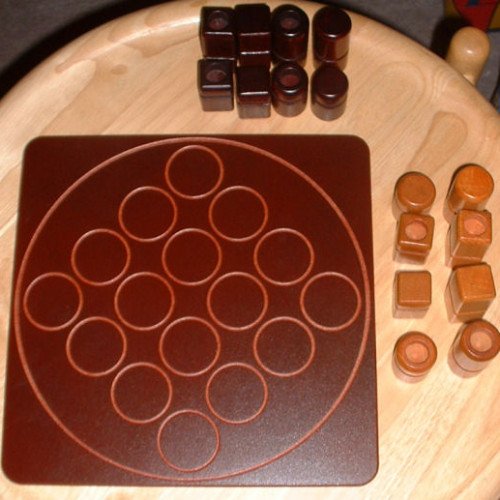HOUNDS AND JACKALS VS QUARTO

HOUNDS AND JACKALS
Hounds and jackals is the modern name given to an ancient Egyptian game that is known from several examples of gaming boards and gaming pieces found in excavations. The modern name was invented by Howard Carter, who found one complete gaming set in a Theban tomb of ancient Egyptian pharaoh Amenemhat IV that dates to the 12th Dynasty. The latter game set is one of the best preserved examples and is today in the Metropolitan Museum of Art in New York. He called it Hounds contra Jackals. Another, less often used modern name is fifty-eight holes. The gaming board has two sets of 29 holes. Gaming pieces are ten small sticks with either jackal or dog heads. The game appeared in Egypt, around 2000 BC and was mainly popular in the Middle Kingdom. In the 1956 movie The Ten Commandments, Pharaoh Seti (Cedric Hardwicke) and Nefretiri (Anne Baxter) are shown playing the game. Hounds and Jackals, also known as 58 Holes, is a well-known Bronze Age board game which was invented in Ancient Egypt 4,000 years ago. Hounds and Jackals appeared in Egypt, around 2000 BC and was mainly popular in the Middle Kingdom. William Mathew Flinders Petrie initially discovered the game and published about it in 1890. More than 40 examples of the game have been revealed in Egypt, Mesopotamia, Israel, Syria, Iran, Azerbaijan, around the Levant and Mediterranean since that time. Sticks were made of expensive materials such as ivory, silver and gold based on the findings at some of the archaeological sites. Wood was also used in the preparation of ordinary pegs, but such examples would not have survived. The complete set of this Egyptian game discovered in 1910 by the British archaeologist Howard Carter is now displayed in the Metropolitan Museum of Art in New York.
Statistics for this Xoptio

QUARTO
Quarto is a board game for two players invented by Swiss mathematician Blaise Müller. It is published and copyrighted by Gigamic. The game is played on a 4×4 board. There are 16 unique pieces to play with, each of which is either: tall or short; red or blue (or a different pair of colors, e.g. light- or dark-stained wood); square or circular; and hollow-top or solid-top. Players take turns choosing a piece which the other player must then place on the board. A player wins by placing a piece on the board which forms a horizontal, vertical, or diagonal row of four pieces, all of which have a common attribute (all short, all circular, etc.). A variant rule included in many editions gives a second way to win by placing four matching pieces in a 2×2 square. Quarto is distinctive in that there is only one set of common pieces, rather than a set for one player and a different set for the other. It is therefore an impartial game.